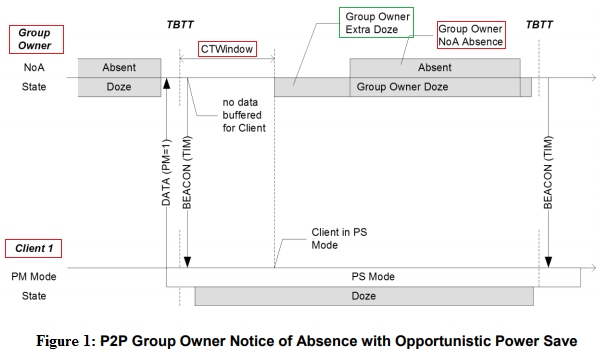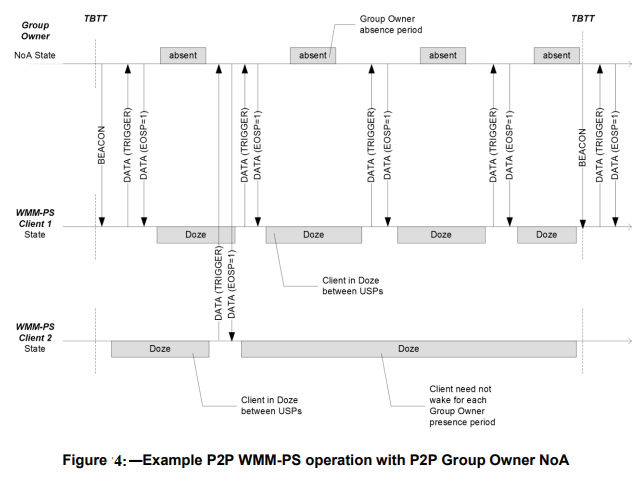In the earlier posts we have learnt about the P2P Opportunistic power save mode and P2P NoA Power saving mechanism. Have a look at the below links for OPPPs and NoA power save methods.
Now we will learn about NoA+Opps mode which will make the Group Owner to sleep for some extra time.
Observe the below figure and understand that , the GO has enabled NoA+OppS power save mode both.

In the above figure Observe that we have a CTWindow which will be used for OppS mode. And We have Group Owner NoA periods as well. We will know briefly about OppS and NoA here, because we have other posts already explained about this. In the CTWindow Group owner will be awake , and serving the clients. And GO should not sleep until after the clients have finished their transmission. So, here GO getting into sleep depends on the all the clients traffic. If there is are no transmissions from the clients after CTWindow, GO can get in to the power save mode.
In NoA period GO will define absence periods, and GO will go to sleep mode on the defined absence periods. Here GO will decide when to get into the DOZE state. If a GO enables both the OppS+NoA then there is a chance that GO can get in to the extra DOZE.
In the above figure observe that OppS+NoA both are enabled. And GO will be awake in the CTWindow, If there are any transmission happening from the clients then GO will not get into the sleep, But GO goes in to sleep when it encounters the NoA Absence period that is being defined by GO. And GO can get into the extra DOZE if there is no transmission happening from the Clients, after CTWindow. Observe the below capture to know the P2P GO OppS+NoA enabled beacon frame.

Order of precedence for P2P GO power save state
The order of precedence for determining P2P Group Owner power save state shall be as follows by the standard:
- Highest: Absence due to a non-periodic Notice of Absence (Count = 1).
- Presence from TBTT until the end of Beacon frame transmission.
- Presence during the CTWindow.
- Lowest: Absence for a periodic Notice of Absence (Count > 1).
This means that for any periodic NoA timing schedule (any NoA schedule where the Count value is greater than 1), the P2P Group Owner shall be present for
each TBTT to send a Beacon frame independent of that Notice of Absence
schedule. It also means that presence during the CTWindow shall take priority
over an absence period related to a periodic NoA schedule when both schemes
are active. When two overlapping Notice of Absence schedules are established, periods of absence shall take priority.
Observe the below figure to properly understand this precedence rules. In the below figure we have a count=1, which is single NoA for one absent period. Count=255 for another NoA which is periodic NoA.

P2P group Owner Power save Delivery
- A P2P Group Owner shall not send frames within the P2P Group during periods that the P2P Group Owner has indicated it will be absent, subject to the power save state precedence rules above.
- A P2P Device should not initiate a frame exchange sequence that cannot be completed prior to the start of an absence period.
- Frames transmitted within the frame exchange sequence need not be received or acknowledged by the receiving P2P Device.
- If the P2P Group Owner receives a PS-Poll frame from a connected P2P Client and is not able to deliver the buffered frame prior to the start of an absence period, it shall defer its transmission until it receives a new PS-Poll from that P2P Client
WMM Power save Delivery in P2P NoA power save at GO
- An additional rule governing the end of a WMM Unscheduled Service Period (USP) shall apply if the P2P Group Owner is using Notice of Absence timing.
- A USP shall end if a P2P Group Owner absence period occurs prior to signaling the end of the USP. When this occurs, the End of Service Period (EOSP) bit in the last frame delivered prior to the absence is 0 and the More bit is 1, indicating that buffered data remains at the P2P Group Owner.
- It is possible that no frames can be delivered in a USP that is terminated by an absence period.
- In either case, the P2P Client shall send another trigger in a subsequent P2P Group Owner NoA presence period to retrieve the undelivered data. This possible shortening of USPs by Group Owner NoA absence periods is shown in the below figure

Power Management at a P2P Client
- A P2P Client that receives a Notice of Absence descriptor shall assume the specified Notice of Absence timing will commence at the indicated Start Time.
- The P2P Client shall not send frames to a P2P Group Owner during periods that the P2P Group Owner has indicated it will be absent, subject to the power save state precedence rules above.
- P2P Clients shall buffer frames until frame delivery can be attempted in a presence period.
- A P2P Device should not initiate a frame exchange sequence that cannot be completed prior to the start of an absence period.
- Frames transmitted within the frame exchange sequence need not be received or acknowledged by the receiving P2P Device.
- A P2P Client determines that a P2P Group Owner has Opportunistic Power Save enabled by the OppPS bit being set to 1 in the CTWindow and OppPS Parameters field of received Notice of Absence attributes.
- In this case, a P2P Client in Power Save mode shall only send frames to a P2P Group Owner during the CTWindow, subject to any non-periodic NoA, and with the exception that the P2P Client shall respond to frames received after the end of the CTWindow in relation to an incomplete WMM Unscheduled Service Period (USP), or outstanding PS-Poll.
- A P2P Client that has requirements on the P2P Group Owner presence periods may submit a P2P Presence Request to the P2P Group Owner to influence P2P Group Owner power management timing. you can see this frame capture from the Post.
- If a P2P Client using P2P Power Save sends a PS-Poll frame to the P2P Group Owner, the P2P Group Owner may be unable to deliver a buffered frame prior to the start of an absence period. When this occurs, the P2P Client may sleep for the P2P Group Owner absence period and shall send another PS-Poll frame.
Observe the below figure for WMM-PS at P2P Group when NoA is enabled.

WMM Power save Delivery in P2P NoA power save at GC
- An additional rule governing the end of a WMM Unscheduled Service Period (USP) shall apply if the P2P Group Owner is using Notice of Absence timing.
- A USP shall end if a P2P Group Owner absence period occurs prior to signaling the end of the USP. When this occurs, the End of Service Period (EOSP) bit in the last frame delivered prior to the absence is 0 and the More bit is 1, indicating that buffered data remains at the P2P Group Owner.
- It is possible that no frames can be delivered in a USP that is terminated by an absence period.
- In either case, the P2P Client shall send another trigger in a subsequent P2P Group Owner NoA presence period to retrieve the undelivered data. This possible shortening of USPs by Group Owner NoA absence periods is shown in the Figure 3.
With this post, topics related to Power Management in WiFi Direct are finished.